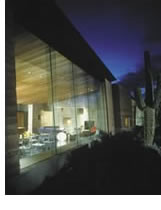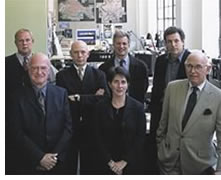

07/2004
National
Design Awards Jury Chooses Finalists in Architecture, Related Fields
The Smithsonian Institution’s Cooper-Hewitt, National Design Museum recently announced recipients and finalists in the fifth annual National Design Awards. The finalists announced were in the categories of architecture design, communications design, environment design, fashion design, and product design. Additionally, Milton Glaser received the Lifetime Achievement Award and the Aveda Corporation won the Corporate Achievement Award.
Glaser, a pivotal figure in graphic design and illustration for more than 50 years, has a body of work that includes logos; ads; posters; and portraits and identities for newspapers, magazines, books, exhibitions, grocery stores, and restaurants. Aveda, since its founding in 1978, has developed solutions to problems by insisting on strong design and aesthetic standards, expressed within shifting parameters of materials and design processes that minimally impact the planet. They will be feted at a gala on October 19, during which the winners in the five finalist categories and the recipient of the Design Patron Award will be announced.
The National Design Awards began as an official project of the White House Millennium Council in 2000. Since then it has expanded its scope to celebrate “design in various disciplines as a vital humanistic tool in shaping the world.” The National Design Awards increase national design awareness by educating the public and promoting excellence, innovation, and lasting achievement. The museum annually invites more than 600 leading American architects, designers, educators, journalists, authors, filmmakers, and other professionals to nominate designers whose work best exemplifies the goals of the National Design Awards.
A panel of six jurors selected the projects: Eliza Bolen, vice president
of licensing, Oscar de la Renta, Ltd.; Ralph Caplan, editor, writer, and
design consultant; Deborah Nevins, landscape designer and historian; Andy
Proehl, Sony Design Center; Christopher Pullman, WGBH Public Broadcasting;
and Álvaro Siza, Álvaro Siza Arquitecto, Lda. 
Architecture Design finalists
- Rick Joy, Tucson. Rick Joy’s work—quietly serene and deliberately simple—derives from a visceral understanding of place. In approaching a new project, site orientation and the sensual experience of the specific sights, sounds, and smells of the site are of primary consideration. Joy shows how efficient and environmentally sensitive architecture can emerge as a byproduct of the timeless qualities that are associated with great architecture.
 Polshek
Partnership, New York City. Founded in 1963, the Polshek Partnership
is known for architectural excellence and a longstanding commitment
to cultural, educational, governmental, and scientific institutions.
James Stewart Polshek, FAIA, and his six partners believe that the most
elegant architectural responses are technically and socially relevant
to time and place. The firm’s architectural solutions are deeply
rooted in a process of collaboration and extensive research.
Polshek
Partnership, New York City. Founded in 1963, the Polshek Partnership
is known for architectural excellence and a longstanding commitment
to cultural, educational, governmental, and scientific institutions.
James Stewart Polshek, FAIA, and his six partners believe that the most
elegant architectural responses are technically and socially relevant
to time and place. The firm’s architectural solutions are deeply
rooted in a process of collaboration and extensive research. Joseph
E. Spear, AIA, Kansas City, Mo. Joseph Spear is one of the world’s
most influential ballpark designers. The founding senior principal of
HOK Sport + Venue + Event, Spear’s body of work has made a significant
impact on how people enjoy the game of baseball. From Baltimore’s
Oriole Park to San Francisco’s SBC Park, his venues have set a
new standard of design for sports facilities.
Joseph
E. Spear, AIA, Kansas City, Mo. Joseph Spear is one of the world’s
most influential ballpark designers. The founding senior principal of
HOK Sport + Venue + Event, Spear’s body of work has made a significant
impact on how people enjoy the game of baseball. From Baltimore’s
Oriole Park to San Francisco’s SBC Park, his venues have set a
new standard of design for sports facilities. Rafael
Viñoly, FAIA, New York City. The founder and principal
of Rafael Viñoly Architects PC, he has been in practice for over
40 years, with projects in the U.S., Latin America, East Asia, and Europe.
His buildings have structural originality, utilizing imagination and
innovation to capture light and air. Viñoly’s work is driven
by the belief that architecture’s essential responsibility is
to elevate the public realm.
Rafael
Viñoly, FAIA, New York City. The founder and principal
of Rafael Viñoly Architects PC, he has been in practice for over
40 years, with projects in the U.S., Latin America, East Asia, and Europe.
His buildings have structural originality, utilizing imagination and
innovation to capture light and air. Viñoly’s work is driven
by the belief that architecture’s essential responsibility is
to elevate the public realm.
Environment Design finalists
This award is given to an individual or firm for exceptional and exemplary
work in landscape architecture, interior design, or set design.
- Andropogon Associates, Ltd., Philadelphia. Formed in 1975, Andropogon Associates was formed to pursue an ecological perspective to problem-solving in environmental planning and landscape architecture. The concept of sustainability is at the core of their practice and their holistic approach considers equally the land and its stewards. The firm’s expertise includes brownfields redevelopment, urban revitalization, and adaptive re-use of historic and cultural sites.
- Ned Kahn, Sebastapol, Calif. An environmental designer with a background in environmental science, Kahn explores natural phenomena through his projects. Typically incorporating fluid dynamics, optics, acoustics, and physics, Kahn’s work is a reminder of nature’s capacity to inspire apprehension, serenity, wonder, and awe. Kahn’s best-known project is Tornado, a simulation of the chaotic phenomenon that allows the viewer to interact with the vapor vortex.
 William
McDonough + Partners, Charlottesville, Va. McDonough’s
work arises from the goal of creating buildings, spaces, and places
with completely positive intentions and effects. William McDonough +
Partners practices international architecture that is ecologically,
socially, and economically sound. In 1999, Time
magazine named William McDonough, FAIA, a “Hero for the Planet,”
stating that “his utopianism is grounded in a unified philosophy
that—in demonstrable and practical ways—is changing the
design of the world.”
William
McDonough + Partners, Charlottesville, Va. McDonough’s
work arises from the goal of creating buildings, spaces, and places
with completely positive intentions and effects. William McDonough +
Partners practices international architecture that is ecologically,
socially, and economically sound. In 1999, Time
magazine named William McDonough, FAIA, a “Hero for the Planet,”
stating that “his utopianism is grounded in a unified philosophy
that—in demonstrable and practical ways—is changing the
design of the world.”
Copyright 2004 The American Institute of Architects.
All rights reserved. Home Page ![]()
![]()
 |
||
| For more
information, visit Cooper-Hewitt online.
|
||